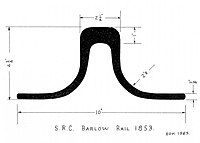Barlow rail

Okay, so imagine you have a toy train that moves on a very straight and smooth track. The track is made up of long pieces of metal or plastic that are placed parallel to each other. The train sits on top of the track and moves forward with the help of a motor inside the train.
Now, there is a part of the track called the Barlow Rail. It is a little different from the other pieces of track. Instead of being a plain, flat piece of metal or plastic, the Barlow Rail is curved, like a little hill. It is called the Barlow Rail because it was invented by a man named Peter Barlow in the 19th century.
So, why is this little hill-shaped Barlow Rail so important? Well, when the train passes over it, it causes the wheels to move closer together, which makes the train more stable and less likely to jump off the track. This is called track gauge widening.
The Barlow Rail is usually placed at certain intervals along the straight pieces of track. This helps the train to maintain its stability and safety as it travels along the track.
In summary, the Barlow Rail is a curved piece of track that helps toy trains to stay on the track and be more stable as they move forward.
Now, there is a part of the track called the Barlow Rail. It is a little different from the other pieces of track. Instead of being a plain, flat piece of metal or plastic, the Barlow Rail is curved, like a little hill. It is called the Barlow Rail because it was invented by a man named Peter Barlow in the 19th century.
So, why is this little hill-shaped Barlow Rail so important? Well, when the train passes over it, it causes the wheels to move closer together, which makes the train more stable and less likely to jump off the track. This is called track gauge widening.
The Barlow Rail is usually placed at certain intervals along the straight pieces of track. This helps the train to maintain its stability and safety as it travels along the track.
In summary, the Barlow Rail is a curved piece of track that helps toy trains to stay on the track and be more stable as they move forward.
Related topics others have asked about:
